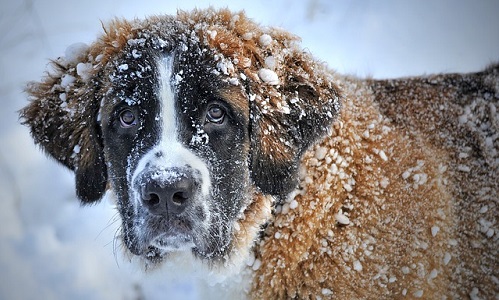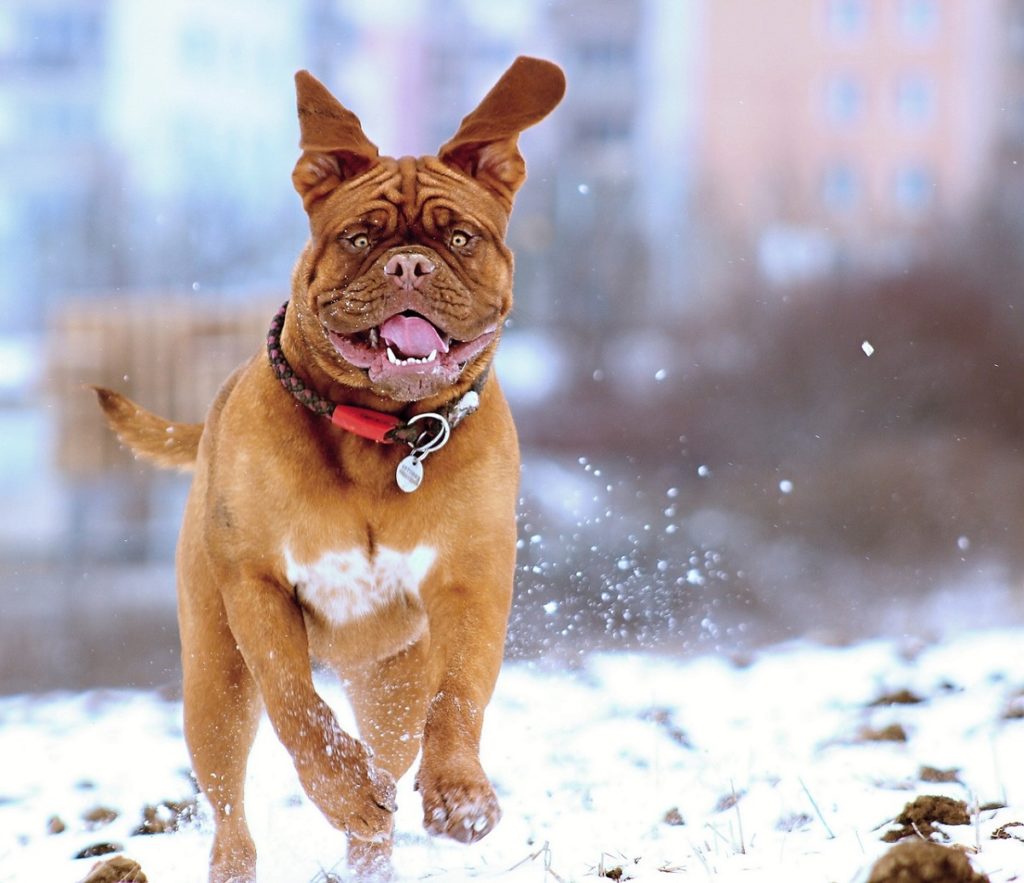Just because a dog is covered in fur, doesn’t mean they can’t still get cold or even freeze and develop life-threatening conditions like hypothermia or frostbite. The reality is they can and often do, especially if they aren’t properly cared for in extreme climates. Remember, if it’s cold for you, it’s cold for your dog too, despite their fur and possible lack of concern.
What is Frostbite on Dogs?
The medical term for frostbite is congelatio. At its core, frostbite is damaged tissue and skin. A dog’s blood vessels carry both oxygen and heat to the skin. When a dog is exposed to extremely cold temperatures for extended periods of time, their blood vessels will constrict in order to conserve heat, especially in the outer extremities. This reduces the flow of blood in these areas to dangerously low levels. If the affected tissue and extremities become so cold they freeze completely, the skin, tissue, and extremities will die. Tissue that dies can become infected and cause additional damage to your dog’s skin and to their overall prognosis.
What Causes Frostbite on Dogs?
Frostbite is caused by prolonged exposure to extremely cold temperatures. Dogs that are exposed first to cold water and then to very cold temperatures are at an even higher risk for frostbite. Generally speaking, temperatures below 32º F are considered unsafe and your dog should only be outside for brief periods or only when necessary. Frostbite can occur in minutes under the right conditions, especially if the weather is particularly wet, windy, and cold.
What Areas are Prone to Frostbite on Dogs?
A dog’s outer extremities tend to be the most vulnerable to frostbite. These include his paws (especially those toes and paw pads), his tail, his face, his ears, and even the scrotum. Other parts of the body can be affected but it’s not nearly as common.
What Dogs are Most Vulnerable to Frostbite?
Some factors can increase the risks of a dog developing frostbite. Dogs that are short-haired or have a thin coat are more susceptible than dogs with longer, thicker coats. Dogs that aren’t used to very cold temperatures are at increased risk as well. Dogs with health conditions that affect the blood flow to their extremities, dogs that are on particular medications, and dogs with a history of canine diabetes and heart disease can all be more prone to frostbite. Additionally, dogs that live outdoors will be more vulnerable to frostbite, even if they have a thicker coat to keep them warm.
What are the Symptoms of Frostbite on Dogs?
 Frostbite can be tough to recognize, especially if you’ve never seen a dog with this condition before. In many cases, pet owners may not even realize a dog has a frostbite injury until days after the fact. This is especially true on areas that are very small, or that don’t bear the dog’s weight. Areas like the tips of a dog’s tail or the tips of their ears are especially vulnerable since it may not cause your pup pain or discomfort.
Frostbite can be tough to recognize, especially if you’ve never seen a dog with this condition before. In many cases, pet owners may not even realize a dog has a frostbite injury until days after the fact. This is especially true on areas that are very small, or that don’t bear the dog’s weight. Areas like the tips of a dog’s tail or the tips of their ears are especially vulnerable since it may not cause your pup pain or discomfort.
Some of the clinical signs of frostbite include:
- Skin discoloration, usually pale gray or blue in color
- Parts or areas that appear swollen
- Areas that cause your dog pain
- Areas that feel cold and brittle to the touch
- Areas that feel rough to the touch
- Skin that looks dead and black in color
- Skin that appears red and inflamed while thawing out
- Skin that has blisters and ulcers
- Skin that is flaking (paw pads and toes especially)
- Pale color, like gray or white (mainly the nose)
- Ice crystals in the nostrils
- You may even notice ice or ice crystals on the skin (especially with ears)
Hopefully, if you can catch these symptoms in time, you can avoid permanent damage to your dog’s skin and tissue. Dogs that have severely damaged skin due to frostbite may suffer from additional symptoms, such as:
- Skin that looks dark blue in color or black
- Skin that is dead and sloughs off your dog (usually after several days to weeks later)
- Skin that has pus and/or a foul smell to it, usually related to a secondary canine bacterial infection
Once areas that have been frostbitten begin to thaw out and warm back up, that’s usually when you will begin to notice the signs like canine skin inflammation, redness, and swelling of the tissue that has been affected. Tissue that has already begun to die will change in color slowly over time, turning dark blue and black in appearance. When this occurs, that’s normally when bacterial infections will develop, which may eventually be followed by pus and a foul odor.
A dog with frostbite will most likely also suffer from hypothermia. The two conditions tend to go hand-in-hand. Hypothermia can prompt additional symptoms like canine lethargy, a drop in body temperatures below 100 F, excessive shivering as your dog’s body attempts to warm itself, movements that are stiff and slow, plus shallow, labored breathing. If you suspect your dog may have hypothermia, even a mild case, it’s important to get them warmed up as quickly as possible and to see your vet. If a dog suffers hypothermia and it isn’t treated right away, he can fall into a coma and die from canine heart failure.
Diagnosing Frostbite on Dogs
You will need to check your dog thoroughly if you suspect he may have frostbite, especially if you know your dog has been outside and exposed to extremely cold temperatures. If you see any signs of frostbite or symptoms of hypothermia, you should contact your vet immediately. Your vet will want a thorough medical history on your dog, do a physical exam to check the dog’s extremities and skin, and in some cases may order blood and urine tests to determine whether or not your dog has suffered any damage to his internal organs.
How to Treat Frostbite on Dogs Paws
Treatment of frostbite needs to happen right away, you can’t wait until you get to the vet. The best thing you can do is to help your dog raise his body temperature. Make sure to keep you dog in a warm and dry place. Wrap the dog in dry blankets or towels to help raise their core temperature, as they will likely also be hypothermic if they have been outside in an extreme climate. You can also try hot water bottles placed around the dog’s body to add additional heat, but not so hot that you accidentally burn him.
Once your dog’s core temperature is warmed up, turn your focus to areas where he may have frostbite. Note that you will not want to try to warm up frostbitten areas if you can’t get your dog inside somewhere warm and dry. Warming tissue and then exposing it again to low temperatures will cause even more damage than what you started with.
To warm up parts of your dog’s body that have been frostbitten, there are several recommended ways to do it. First, never rub or squeeze areas that are affected as you could cause additional damage. You can try warming a towel with an external heat source (like a blow dryer) and then wrapping the warm towel around the areas that are affected. Never blow a hair dryer or heating pad directly on your dog’s skin.
 You can also use warm or tepid water (never hot water) and soak the areas that are affected or use wet compresses to soak the area and warm it up slowly. It should feel comfortable to the touch. Once the affected areas are warmed and no longer frozen, you can carefully pat them dry. Keep them warm by wrapping them in fresh towels or blankets from the dryer, and transport them to the vet as soon as possible.
You can also use warm or tepid water (never hot water) and soak the areas that are affected or use wet compresses to soak the area and warm it up slowly. It should feel comfortable to the touch. Once the affected areas are warmed and no longer frozen, you can carefully pat them dry. Keep them warm by wrapping them in fresh towels or blankets from the dryer, and transport them to the vet as soon as possible.
Once you arrive at the vet, your dog may require further treatment for his hypothermia. Your vet may provide your dog with pain medication if your dog appears to be suffering. To start the treatment process, the vet may also provide fluids for your dog as well as antibiotics to prevent or treat infection, especially if they suspect the dog’s tissue is dead or dying.
In the worst cases, amputation may be necessary so that infection and tissue necrosis doesn’t spread, especially if the frostbitten area covers a large section of tissue. In most cases, frostbite in dogs will be fairly mild. It’s when frostbite affects large areas of the body that prognosis is poor and recovery may be difficult. Permanent damage and disfigurement is possible in extreme cases.
Preventing Frostbite on Dogs
The best way to prevent your dog from getting frostbite is to keep him safe from extremely cold temperatures for long periods of time. If your dog is exposed to very cold temperatures, it should be for very short periods of time. You can also try to keep your dog warm with dog accessories, such as dog sweaters or jackets and dog boots to wear when they go outside in the snow.
Every dog is different, and some dogs may be more willing to wear their booties over others. Dog apparel can be especially useful for pups that aren’t used to cold weather or have less fur. It’s also good to keep elderly dogs and small pups warmer, since they are known to have weaker immune systems.
Dogs with health conditions are also susceptible to frostbite and hypothermia. Conditions that impair blood flow, coupled with extremely cold climates serve as a double-whammy and create more risk for frostbite in your dog than if he was healthy.
The signs and symptoms of frostbite on dogs can be tough to discern if you don’t know what you’re looking for. It’s important to educate yourself and if you suspect your dog may have been overly exposed, take steps to begin warming them up immediately. From there, call your vet as soon as possible. Additional care may be essential for saving your dog’s life in extreme cases of frostbite.
Sources:
- “Frostbite on Dogs.” PetMD, 19 Nov. 2018, www.petmd.com/dog/emergency/common-emergencies/e_dg_frostbite.
- “Frostbite in Dogs.” VCA Hospitals, www.vcahospitals.com/know-your-pet/frostbite-in-dogs.
- “A Chilly Question,… Can Dogs Get Frostbite or Hypothermia?” Daily Dog Stuff, 26 Jan. 2019, www.dailydogstuff.com/can-dogs-get-frostbite-or-hypothermia/.
- “How to Recognize Signs of Frostbite and Hypothermia in Dogs.” Orvis News, 17 Jan. 2017, www.news.orvis.com/dogs/recognize-signs-frostbite-hypothermia-dogs.




